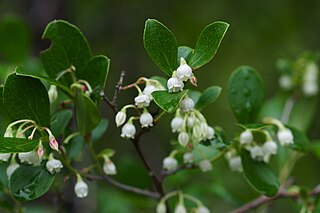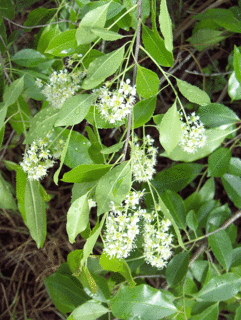
Cercis canadensis, the eastern redbud, is a large deciduous shrub or small tree, native to eastern North America from southern Michigan south to central Mexico, east to New Jersey. Species thrive as far west as California and as far north as southern Ontario, roughly corresponding to USDA hardiness zone 6b. It is the state tree of Oklahoma.

Aesculus pavia, known as red buckeye or firecracker plant, is a species of deciduous flowering plant. The small tree or shrub is native to the southern and eastern parts of the United States, found from Illinois to Virginia in the north and from Texas to Florida in the south. It is hardy far to the north of its native range, with successful cultivation poleward to Arboretum Mustila in Finland.

Pistacia chinensis, the Chinese pistache, is a small to medium-sized tree in the genus Pistacia in the cashew family Anacardiaceae, native to central and western China. This species is planted as a street tree in temperate areas worldwide due to its attractive fruit and autumn foliage.

Acer leucoderme is a deciduous tree native to the southeastern United States from North Carolina south to northwest Florida and west to eastern Texas. It lives in the understory in moist, rocky soils on river banks, ravines, woods, and cliffs. Although generally an uncommon tree, it is most often found in the inner coastal plain and Piedmont regions of Georgia.

Vaccinium arboreum is a species of Vaccinium native to the southeastern and south-central United States, from southern Virginia west to southeastern Nebraska, south to Florida and eastern Texas, and north to Illinois.
Manilkara mayarensis is a plant species in the family of sapodillas, which grows wild only in Cuba's Oriente Province. Here its members range in scale from shrubs to small trees. Its usual haunts are along creeks, ravines and other naturally formed watercourses within its montane, serpentine shrubwood habitat.
Manilkara pleeana, the zapote de costa, is a species of plant in the family Sapotaceae. It is endemic to Puerto Rico.
Manilkara valenzuelana is a species of tree or tall shrub in the Sapodilla family. It is found in coastal and subcoastal semi-deciduous forests of Cuba, the Dominican Republic, Haiti, and possibly Puerto Rico. Its habitat has been declining rapidly under pressure from charcoal makers, logging, and the clearing of forest for human habitation.

Plumeria obtusa, the Singapore graveyard flower, is a species of the genus Plumeria (Apocynaceae). It is native to the West Indies, southern Mexico, Belize, Guatemala, and Florida. but widely cultivated for its ornamental and fragrant flowers around the world, where suitably warm climate exists. It is reportedly naturalized in China.

Randia aculeata, commonly known as white indigoberry or white indigo berry, is a species in the Rubiaceae. It is a shrub or small tree that grows from 2 to 6 m tall. R. aculeata is native to Florida, Bermuda, the Bahamas, elsewhere among the Caribbean islands, and also from Mexico south through Central and South America to Colombia.
Sideroxylon salicifolium, commonly called white bully or willow bustic, is a species of flowering plant native to Florida, the West Indies and Central America. It has also been considered a member of the genus Dipholis, with the binomial Dipholis salicifolia.

Zanthoxylum fagara or wild lime, is a species of flowering plant that—despite its name—is not part of the genus Citrus with real limes and other fruit, but is a close cousin in the larger citrus family, Rutaceae. It is native to southern Florida and Texas in the United States, and to Mexico, Central America, the Caribbean, and South America as far south as Paraguay. Common names include: lime prickly-ash, wild lime, colima, uña de gato, and corriosa.

Sideroxylon celastrinum is a species of flowering plant in the family Sapotaceae, that is native to Texas and Florida in the United States south through Central America to northern Venezuela and Colombia in South America. Common names include saffron plum and coma. It is a spiny shrub or small tree that reaches a height of 2–9 m (6.6–29.5 ft). The dark green leaves are alternate or fascicled at the nodes and oblanceolate to obovate. Greenish-white flowers are present from May to November and are followed by single-seeded, blue-black drupes.

Frangula caroliniana, commonly called the Carolina buckthorn, is a deciduous upright shrub or small tree native to the southeastern, south-central, and mid-western parts of the United States, from Texas east to Florida and north as far as Maryland, Ohio, Missouri, and Oklahoma. There is also an isolated population in the State of Nuevo León in northeastern Mexico. It is found in a wide variety of habitats, including barrens, forests, and limestone bluffs.

Flacourtia indica, known commonly as ramontchi, governor's plum, Madagascar plum and Indian plum, is a species of flowering plant native to much of Africa and tropical and temperate parts of Asia. F. indica and F. ramontchi are sometimes treated as separate species.

Prunus caroliniana, known as the Carolina laurelcherry, Carolina cherry laurel, Carolina cherry, or Cherry laurel, is a small evergreen flowering tree native to the lowlands of Southeastern United States, from North Carolina south to Florida and westward to central Texas. The species also has escaped into the wild in a few places in California.

Psychotria nervosa, also known as Seminole balsamo or wild coffee, is a shade tolerant medium-sized shrub native to Florida as well as the West Indies and Central and South America. It produces a "small, red, ellipsoid fruit" that resembles "the true coffee bean" in shape and attract birds. Its maximum height ranges from approximately 4–10 feet.

Cucurbita okeechobeensis, the Okeechobee gourd, is a species of gourd in the family Cucurbitaceae, native to Mexico and the United States. There are two subspecies; one is endemic to Florida, primarily in the region around Lake Okeechobee, the other to the State of Veracruz in eastern Mexico. Once abundant, it has state and federal listing as an endangered species. One of its peculiarities is the yellow corolla not so common in other Cucurbita species.

Styrax americanus, the American snowbell or mock-orange, is a plant species native to the southeastern United States and the Ohio Valley. It has been reported from Texas and Florida to Virginia and Missouri. It generally grows in swamps and on floodplains and in other wet locations.
















